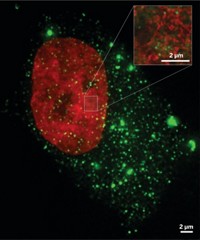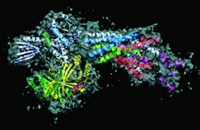Advertisement
Grab your lab coat. Let's get started
Welcome!
Welcome!
Create an account below to get 6 C&EN articles per month, receive newsletters and more - all free.
It seems this is your first time logging in online. Please enter the following information to continue.
As an ACS member you automatically get access to this site. All we need is few more details to create your reading experience.
Not you? Sign in with a different account.
Not you? Sign in with a different account.
ERROR 1
ERROR 1
ERROR 2
ERROR 2
ERROR 2
ERROR 2
ERROR 2
Password and Confirm password must match.
If you have an ACS member number, please enter it here so we can link this account to your membership. (optional)
ERROR 2
ACS values your privacy. By submitting your information, you are gaining access to C&EN and subscribing to our weekly newsletter. We use the information you provide to make your reading experience better, and we will never sell your data to third party members.
Biological Chemistry
Flipping the Switch
Researchers are learning to turn gene transcription on and off with transcription factors of their own making
by Sarah Everts
February 19, 2007
| A version of this story appeared in
Volume 85, Issue 8

The genome boasts a wealth of information. But to profit from this capital, the protein machinery that decodes the genome must be recruited to the right place, at the right time.
Thousands of natural transcription factors turn genes on, or, in more technical parlance activate them, by enticing RNA polymerase and its protein entourage to specific locations in the genome, thereby initiating the transcription of genes into messenger RNA, a step toward protein production.
"Biologists have a great model that says transcriptional activators are like a molecular Velcro that brings the transcriptional machinery to a specific gene," explains Anna K. Mapp, a chemist at the University of Michigan. "This enables that gene to be turned on."
Gene-activating transcription factors also set the stage for RNA polymerase by unwinding DNA from where it is tightly packed around histone proteins and by enlisting enzymes to remove chemical marks on the genome that end up blocking the polymerase's progress.
In addition, transcription factors can turn off genes by physically obstructing transcription machinery from assembling on DNA or by jamming RNA polymerase in midtranscription.
Because these transcription factors play a pivotal role as gatekeepers for which genes are turned on and which ones are silenced, many researchers are seeking to design molecules that mimic them. "The idea is to intervene in the 'software' of gene expression," explains Peter B. Dervan, a chemist at California Institute of Technology. Diseases such as cancer are caused by the muting or overexpression of genes. Artificial transcription factors could render the power of precise gene transcription into a therapeutic.
Precise control of gene expression with synthetic transcription factors also would be a useful tool for understanding and manipulating the fate of cells. Aseem Z. Ansari, a biochemist at the University of Wisconsin, Madison, points out that Japanese researchers recently used just four transcription factors to turn fibroblast cells, which are ubiquitous components of connective tissue, into cells that behaved like embryonic stem cells (Cell 2006, 126, 663). "That's really exciting," Ansari says. One day researchers might be able to synthesize artificial transcription factors that could "take differentiated adult cells to a stem-cell-like state" by turning on the genes that code for stem cell properties and turning off the genes that lead to a differentiated state.
To function as a synthetic transcription activator, the mimic must first be able to bind DNA at precise positions within the genome. A DNA-binding domain itself could act as an inhibitor of gene expression by blocking or even evicting normal gene-activating transcription factors. But turning a gene on synthetically is considered the sweeter achievement. It requires a molecule with two functions: a DNA-binding domain and a module that somehow recruits the protein machinery required to transcribe a gene.
This month's report of a small RNA that can activate transcription (C&EN, Feb. 5, page 8) may establish a new area for artificial transcription factor development, but there already are two existing strategies: small-molecule activators and protein-based zinc-finger activators. Zinc fingers are engineered DNA-binding proteins that can robustly activate genes, but the only way to get these proteins into the nucleus is through gene therapy. A harrowing requirement of this approach is ensuring that the artificial transcription factor genes aren't inserted into the genome at the wrong place, where they might disrupt normal genes and initiate cancer. In spite of these challenges, the Richmond, Calif.-based biotech firm Sangamo has managed to usher protein-based gene activation strategies into Phase II clinical trials.
A second strategy to develop transcription factor mimics entails creating small-molecule transcription factors that are cell permeable. "Taking a pill that would turn off a gene in cancer or increase melanin expression in your skin so that you don't get a sunburn" is years away, but it would be a tremendous achievement, says Carlos F. Barbas III, a Scripps Research Institute researcher who studies protein-based activators. The small-molecule approach has lagged behind tactics based on engineered proteins, but recent advances bode well.
Building a sequence-specific DNA-binding domain—the first component of a small-molecule transcription factor mimic—"was a mountain we scaled in the 1990s," Dervan says. By linking together polyamide dimers with three types of aromatic rings—pyrroles, imidazoles, and hydroxypyrroles—his group built a structural platform for differentiating each of the genetic base pairs: adenine and thymine and guanine and cytosine.
The polyamide dimers fold into a hairpin that slips into the minor groove of the DNA helix and forms hydrogen bonds with the purine and pyrimidine bases. Hairpins that recognize up to 16 sequential base pairs can be built to further attempt to guarantee that the polyamides will go to one and only one spot on the genome. However, six- to eight-base-pair-recognizing moieties are the current cutoff for entering the cell.
As such, there is considerable effort to reduce the size of the DNA-binding domains. "The first generation of synthetic factors will almost certainly be built with Dervan polyamides as the DNA-binding moiety," says Thomas J. Kodadek of the University of Texas Southwestern Medical Center, in Dallas. "Unless you want to start an enormous program in the discovery of new DNA-binding molecules, Dervan's are pretty much the only game in town."
When Dervan's team set out to devise small molecules that could bind to genetic sequences, there was little DNA structural data to use as a model, he says.
Thirty years later, researchers face similar challenges as they try to design activation domain mimics, the second component of small-molecule gene switches. "The challenge is that there's not a ton of structural information about activation domains or their binding partners," Mapp says. "So it is difficult to do structure-based design."
What researchers do know is that thousands of natural activation domains are involved in human gene transcription. For transcription to occur, small endogenous transcription factors recruit and assemble the behemoth multiple-protein transcriptional machinery. One strategy for designing artificial activation domains is to present small portions of endogenous transcription factors to entice components of that machinery to the gene of interest.
The first chimera combining activation and DNA-binding components emerged from the collaborative efforts of Mapp, Ansari, Dervan, and Mark S. Ptashne at the Sloan-Kettering Institute in what Kodadek rates as "a tour de force of organic synthesis."
"They built the polyamide and a long polypeptide that corresponded to a domain from a real transcription factor in separate linear syntheses, then ligated these together," Kodadek says.
Researchers since have discovered synthetic small-molecule activators based on a molecular reality that biologists have long recognized: amphipathic helices of hydrophobic and charged repeats seem to be a common thread in natural activation domain complexes. So Mapp's group set out to design a small molecule that presents a hydrophobic surface as an activation domain, and they achieved their goal with an isoxazolidine. Motonari Uesugi, a chemical biologist at the University of Kyoto, in Japan, developed another synthetic activation domain—dubbed wrenchnolol—based on the structure of a native activator-coactivator complex. Ansari's and Dervan's groups are developing tetrapeptide mimics that act as "hooks" to recruit other proteins involved in attracting the transcription machinery to DNA.
The challenge has been to get DNA-binding and activation domain chimeras to penetrate the cell's nucleus and initiate gene transcription endogenously. Although the DNA-binding domain or activation domain alone may be able to enter a cell, the combination can be obstinate about traveling all the way through to the nuclear envelope. For example, Richard A. Young of the Whitehead Institute for Biomedical Research successfully turned on genes with a peptide-based activator, but his method relied on permeabilizing agents to get the activators across both the cell and nuclear membranes.
In an exciting development, Kodadek reports that a chimera of a peptoid activation domain and a polyamide DNA-binding domain can successfully cross the membrane and activate gene expression. The work is currently in press at Angewandte Chemie.
"The good news is that we have some activity inside a cell, the bad news is that it's not great compared to native" gene-activating transcription factors, Kodadek says. His group hopes to further reduce the size of the mimic and improve its efficacy.
As research revealing more about the biology of natural transcription factors comes to light, those trying to design synthetic mimics hope to capitalize on the insights. For example, many endogenous transcription activators possess a "masking domain" that prevents them from aggregating and degrading. Mapp and Ansari want to add this masking capability to new designer activation domains. They hope this will increase the domains' potency.
But when it comes to designing artificial transcription factors, the elephant in the room is epigenetics (C&EN, July 17, 2006, page 13). More specifically, genomic DNA can be methylated, tightly wound around histone proteins, and then further packed into chromatin. Even if researchers design transcription factor mimics with perfect activation domains and DNA recognition, these mimics may not be able to physically access the gene of interest.
This is where small-molecule activators may have a leg up on protein-based ones, says Ansari. Because polyamide hairpins bind in the minor groove, their binding affinities are not affected by the methylation found in DNA's major groove, which is also where engineered zinc-finger protein activators bind. Furthermore, Dervan and collaborator Joel M. Gottesfeld at Scripps have shown that polyamide hairpins can slip deep within a chromatin package and sometimes disrupt its structure, perhaps opening a path for activators to reach buried genes.
But if small-molecule synthetic transcription factors are to prove their promise, chemists must further minimize the DNA-binding domains and activation domains so they can enter cells, but not so much as to lose activation potency, Mapp says. "Don't focus on experiments in test tubes," Kodadek adds. "Let's try to get these things to work in cells."
It's a challenge that will take a can-do attitude. "If small-molecule transcription factors are not consistently working in living organisms, it's because we haven't figured out the general solution to delivering these compounds," Ansari says. "But the solution must surely exist."
Read More
- Flipping the Switch
- Researchers are learning to turn gene transcription on and off with transcription factors of their own making
- 'Zinc Fingers' That Flip The Genetic Switch





Join the conversation
Contact the reporter
Submit a Letter to the Editor for publication
Engage with us on Twitter